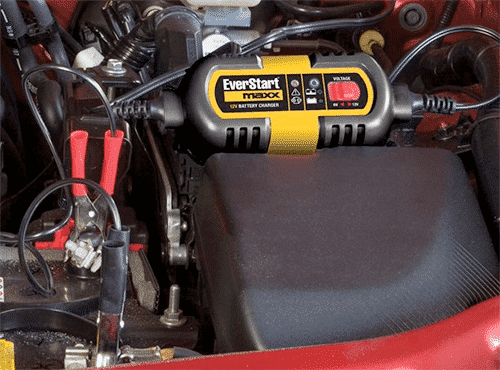Last Updated on December 1, 2023
As a car owner, you may have wondered at some point how long your car can sit without being driven. It’s an important question to ask if you’re going to be gone for an extended period of time. The last thing you need is your car deteriorating while it’s parked.
How long can a car sit without being driven is two weeks. But that’s not taking into account the weather, age, battery life, and overall condition of the vehicle. Another factor is where you’ll park your car. Will it stay inside a dry garage or will the vehicle be outside?
There are many factors to consider when planning to park your car for extended periods of time. Read on to learn the answers to these questions and more below.
How Long Can A Car Sit Without Being Driven Depends on the Environment
When it comes to how long a car can sit without being driven the environment you leave it in plays an important role. For example, do you plan on leaving the car outside in direct sunlight during the summer months? Or will the car be sitting outside during cold wintry months? Both conditions aren’t kind to your beloved car, but in different ways. Let’s examine.
Will the Car be Parked Outside During Summer Months?
If your car sits for long periods under direct sunlight, it’s exterior weather stripping begins to dry. That drying effect eventually leads to failure of the weather stripping. This allows water to leak inside the vehicle and increase wind noise when driving.
The sun’s UV rays aren’t kind to your cars paint or headlights either. Prolonged exposure can cause the clear coat of your paint to peel and flake. Headlights begin to yellow and haze due to the prolonged sun exposure too.
Also, prolonged periods of hot sun isn’t very kind to your cars interior either. You may begin to notice that soft leather steering wheel begin to dry or even crack. The dashboard may even begin to warp and crack. And goodbye to the smell of that air freshener hanging from the mirror.
So here’s the deal – if you need to park your car under the hot sun for any amount of time beyond two weeks, consider having the car professionally detailed. Having a fresh coat of wax and protectants applied to the interior will help ward off any negative effects from the sun’s harmful UV rays.
Will the Car be Parked Outside During Winter Months?
Winter is the worst for cars. If sitting parked for days or weeks with no one to drive them, it starts taking its toll quickly! The first casualties to cold weather conditions typically are the tires and the battery–or batteries for you EV owners.
Consider this, the change between day and night winter temperatures may average about 20°F. When your vehicle sits outside during a cold night, you may see a decrease of 1-4 psi of air in your tires. Over a period of a few weeks you may lose enough air that the tires begin to look flat.
Leaving a car to sit on flat tires is not very kind to its sidewalls, and will likely weaken the overall structure of the tire.
Tire experts recommend over filling your tires by just a few PSI before leaving the car to sit for long periods. This will ensure no matter how much the temperature fluctuates, the tires hold enough pressure to remain structurally sound.
Will my Car Battery Go Flat if Not Driven?
Car batteries aren’t fans of your vehicle sitting unused either. Your car battery might be able to last a few days if not driven very often. Even while your laying on the beach soaking up those suns rays, your car battery is always being used in some fashion, which means it will continue to drain.
Expect a car battery to last four weeks, but it will vary based on your vehicle and age. Leaving your car to sit unused longer than that will affect the batteries ability to start the car.
You may need a jump start to get your car started again. If this is the case, make sure you leave it running for about 30 minutes so that its battery can charge fully before driving off into the sunset.
Is it OK to Park on Grass?
You may think that it’s a good idea to park your car on grass, but you would be wrong. Moisture that is absorbed through the grass and soil, evaporates straight up to the underneath of your car – especially if left parked for extended periods!
The moisture from evaporation causes corrosion to metal surfaces, and accelerates rust on the body of the vehicle.
It can even begin to dry rot the rubber bushings in the suspension. Parking on pavement is always the best option.
Will the Car be Parked Inside?
Parking your car inside for extended periods of time is a great way to keep it from getting damaged by the elements. By parking your car in a garage or other enclosed space, you can protect it from rain, snow, and sun damage. The garage is your friend when it comes to keeping all of those mechanical and electrical bits safe.
Well then, I can park my car in the garage for longer than two weeks without worry? Not so fast. You will still need to deal with potential of a flat battery and tires that lose air pressure.
Maintaining the Battery When Parked Inside
The best option for keeping your battery charged is a trickle charger with an automatic maintenance mode. This type of power supply can be left attached permanently, and it will take care in ensuring that you never have drained batteries again!

Maintaining the Tires When Parked Inside
Your tires will sure love being parked inside away from the elements. But that doesn’t mean you can park the car for two weeks without first giving them a little love.
Even with just one week of sitting on your tires, flat spots can form and cause permanent damage. You will want to ensure that the tires get inflated to the manufacturer’s recommended pressures. This will help avoid the dreaded ‘flat spots’ and help maintain the structure of the tire.
Will the Gas in My Car Go Bad?
If you’re concerned about your car’s gas going bad, we have some good news. The most common type of gasoline sold at a standard gas station can last up to three months. Gasoline does degrade over time, but not as much at first. It’s true gas will naturally begin to degrade over time thanks to exposure to oxygen.
You can never be too careful with your car, especially in this economy. That’s why we recommend adding some extra insurance by using a fuel stabilizer. Fuel stabilizers are a great way to keep your gas safe from degradation. They slow down the rate at which it oxidizes, making for longer lasting fuel in your garage!

Should I Start my Car Periodically?
Yes, in order to keep your car in top shape you should start it at least once every week. The best thing to do is to take a car out for 15-20 minutes once every two weeks. Try to reach a speed of at least 50 miles per hour. This makes sure that all the components and fluids in the engine and transmission get to reach optimal temperature. And, of course, this charges the battery too!
Final Thoughts: How Long Can A Car Sit Without Being Driven
So, there you have it. Our guide to keeping your car parked for weeks on end without any major issues. They’ll help make sure that your car is in good condition when you finally take it out for a drive. We hope this post helps answer the question: how long can a car sit without being driven.
Have you ever had to park your car for an extended period of time? If so, what did you do to make sure it stayed in good condition? Share your tips in the comments below!

Managing Editor
Christopher is an automotive technical writer. When he’s not at the local autocross event, he can often be found working on one of his cars. Specializes in automotive class action law, industry trends, and automotive maintenance. Email me direct, or learn more about us

